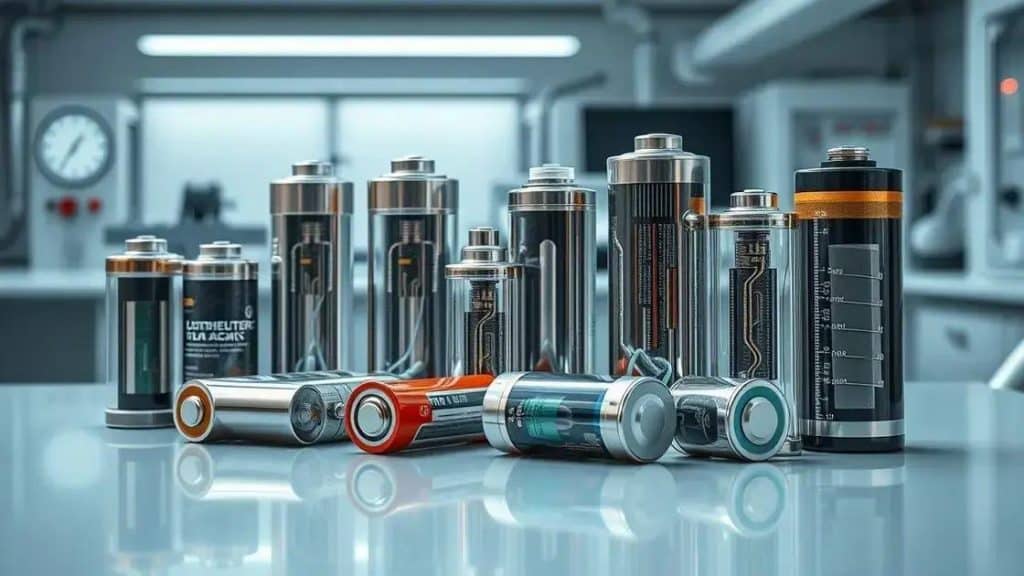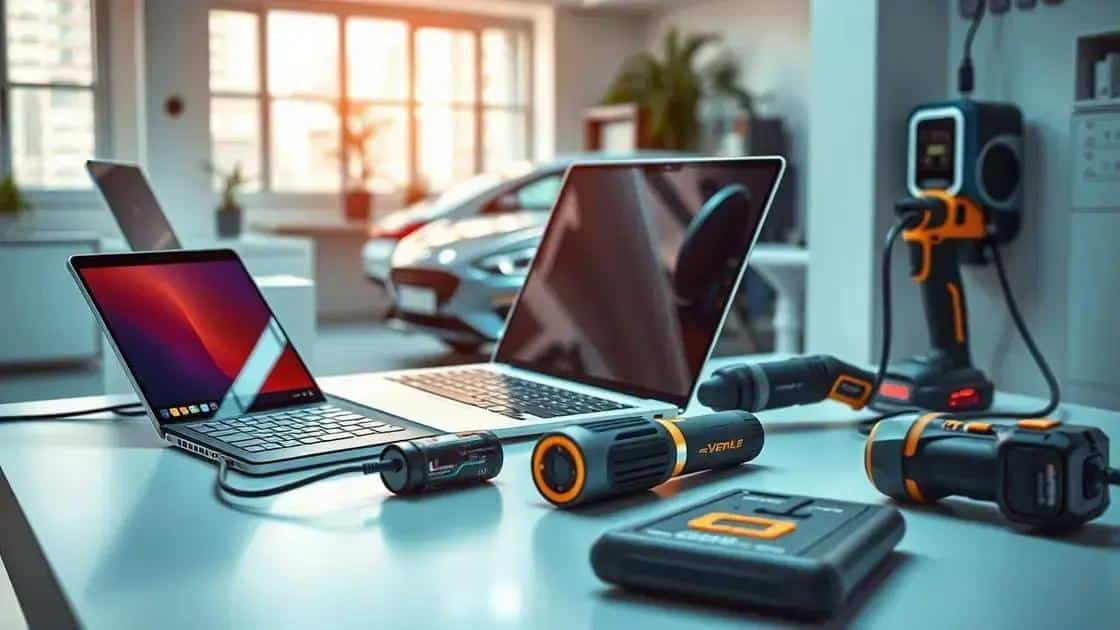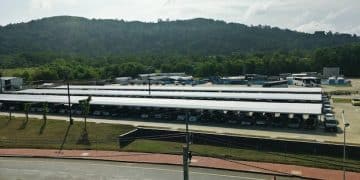Lithium-ion battery advancements: powering the future

Lithium-ion battery advancements significantly enhance energy storage solutions, offering improved efficiency, longer lifespans, and increased safety, while addressing environmental impacts through sustainable practices and recycling efforts.
Lithium-ion battery advancements are changing the landscape of energy use and storage. Have you ever wondered how these batteries power your smartphones and electric cars? Let’s dive into the latest developments in this essential technology.
Recent breakthroughs in lithium-ion technology
Recent advancements in lithium-ion technology have opened new doors for energy efficiency and battery performance. As we strive for a more sustainable future, these innovations are crucial for powering our everyday devices.
High-capacity batteries
New materials and designs have enabled the production of high-capacity lithium-ion batteries. This means they can store more energy and last longer than their predecessors, which is essential for electronics and electric vehicles.
- Increased energy density
- Longer lifecycle
- Faster charging times
Research is also focusing on improving safety. Many breakthroughs include the development of batteries that are less likely to overheat or catch fire. These safer batteries will enhance consumer trust in lithium-ion technology.
Solid-state batteries
Another significant development is the shift towards solid-state batteries. Unlike traditional lithium-ion batteries, which use liquid electrolytes, solid-state batteries use solid electrolytes. This change improves safety and energy density.
- Better thermal stability
- Reduced risk of leakage
- Higher efficiency
The future looks promising as these developments pave the way for electric vehicles with longer ranges and consumer electronics that run longer on a single charge. Recent breakthroughs in lithium-ion technology are reshaping how we think about energy usage and efficiency.
Applications of lithium-ion batteries in everyday devices

Applications of lithium-ion batteries are vast and varied, playing a vital role in our everyday devices. From smartphones to electric vehicles, these batteries power the technology we rely on daily.
Smartphones and tablets
Most of us use smartphones and tablets every day, and lithium-ion batteries make them possible. These batteries provide high energy density, allowing devices to run longer without frequent recharges. Innovations in technology have led to faster charging times and improved safety, making our devices more reliable than ever.
- Longer battery life
- Quick charging capabilities
- Safety improvements
Another common application is in laptop computers, which use lithium-ion batteries to allow portability and convenience for users. The lightweight design and capacity to be recharged many times enhance user experience in both personal and professional settings.
Electric vehicles
The automotive industry heavily relies on lithium-ion batteries for electric vehicles (EVs). These batteries provide the necessary energy to operate efficiently, offering longer ranges and quick acceleration. The shift towards electric vehicles is crucial for reducing emissions and promoting sustainable transportation.
- High energy storage capacity
- Drastically lower running costs
- Reduced environmental impact
Additionally, lithium-ion batteries power many household items, including power tools and garden equipment. The reliability and durability of these batteries have transformed the way we work and manage chores around the house. Every battery-powered tool and gadget we use benefits from the advancements made in lithium-ion technology, enhancing efficiency and user convenience.
Future trends in lithium-ion battery development
Future trends in lithium-ion battery development suggest exciting advancements that may change the way we use energy. As technology continues to evolve, researchers are focusing on increasing efficiency, sustainability, and safety in battery design.
Enhanced energy density
A primary focus of future developments is enhancing energy density. This improvement means that batteries can store more energy in smaller packages. Greater energy density results in longer-lasting devices, which is particularly beneficial for electric vehicles and portable electronics.
- Innovative materials like silicon anodes
- Development of new battery chemistries
- Multi-layer designs for greater capacity
Another crucial trend is improving battery lifespan. By minimizing wear and tear, batteries will not only last longer but also maintain performance over time. This longevity will lead to less frequent replacements, reducing waste and environmental impact.
Sustainable manufacturing processes
As sustainability becomes a more pressing issue, the focus on eco-friendly manufacturing processes is essential. Future trends indicate a shift toward using recycled materials in battery production. This shift can significantly decrease the carbon footprint of battery manufacturing.
- Recycling existing batteries for raw materials
- Eco-friendly solvents and materials in production
- Localizing production to reduce transportation emissions
Moreover, increasing the safety of lithium-ion batteries is paramount. Researchers are investigating solid-state batteries and new electrolyte options that can minimize risks such as overheating and fire. These innovations will not only enhance consumer trust but also open new applications in various sectors.
Environmental impacts of lithium-ion battery production

The environmental impacts of lithium-ion battery production are significant and deserve close attention. As the demand for batteries continues to rise, understanding these impacts is crucial for sustainable practices.
Resource extraction
Mining for lithium, cobalt, and nickel—key components of lithium-ion batteries—can cause substantial environmental disruption. Mining operations often lead to habitat destruction and water shortages in nearby areas. The extraction processes can generate pollution and contribute to land degradation.
- Destruction of natural habitats
- Water resource depletion
- Soil contamination from mining runoff
As more companies seek to address these issues, efforts to improve extraction techniques are underway. Producing batteries with less harmful materials and better methods can minimize environmental damage.
Energy usage during production
The process of manufacturing batteries requires significant energy, often sourced from fossil fuels. This high energy consumption contributes to greenhouse gas emissions. Reducing energy use during production is essential for making lithium-ion battery production more sustainable.
- Utilizing renewable energy sources
- Implementing energy-efficient technologies
- Optimizing production processes
Additionally, the disposal of lithium-ion batteries poses environmental challenges. Improper disposal can lead to toxic substances leaching into the soil and water supply. Promoting recycling and proper waste management practices is vital to mitigate these risks and reclaim valuable materials from spent batteries.
Recycling initiatives can reduce the need for new raw materials and lessen the overall environmental footprint associated with lithium-ion battery production. These practices not only conserve resources but also support a circular economy that benefits the planet.
Conclusion: The development of lithium-ion batteries has transformed the way we use energy in our everyday lives. While these batteries bring many benefits such as increased efficiency and convenience, their production also poses significant environmental challenges. By focusing on sustainable practices, improving recycling efforts, and enhancing safety, we can help ensure that advancements in lithium-ion technology benefit both users and the planet. As technology continues to evolve, embracing these changes will be crucial for a greener future.
FAQ – Frequently Asked Questions about Lithium-Ion Batteries
What are the main components of lithium-ion batteries?
Lithium-ion batteries are primarily made up of lithium, cobalt, nickel, and graphite, which are crucial for energy storage and performance.
How does lithium-ion battery production affect the environment?
The production of lithium-ion batteries can lead to resource extraction issues, pollution, and significant energy consumption, impacting ecosystems and contributing to greenhouse gas emissions.
What are some future trends in lithium-ion battery technology?
Future trends include increased energy density, improved recycling methods, sustainable manufacturing processes, and advancements in safety measures.
How can I recycle lithium-ion batteries?
You can recycle lithium-ion batteries by taking them to designated recycling centers, participating in take-back programs, or returning them to retailers that offer recycling services.





